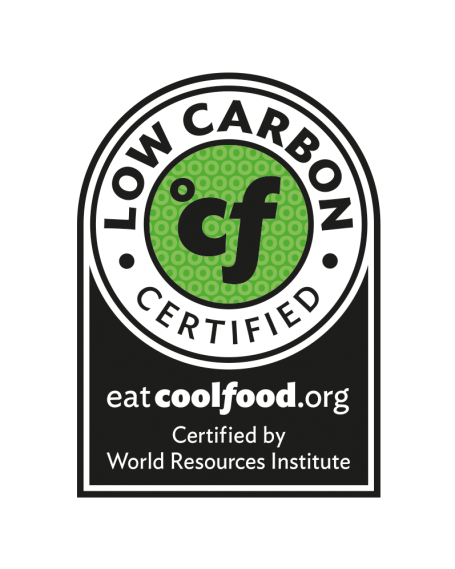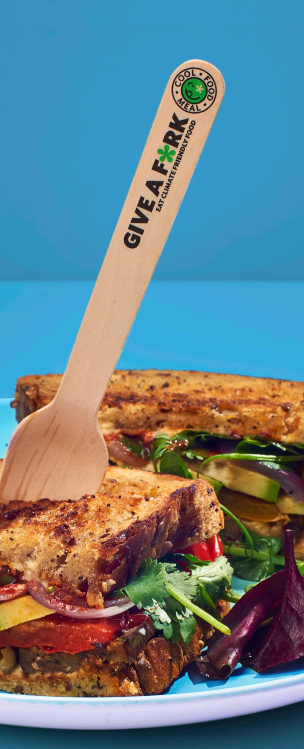Coolfood
Coolfood – World Resources Institute’s (WRI) initiative for curbing diet-related emissions – provides the food service industry with the tools and expertise to reduce emissions by 25% by 2030, in line with the goals of the Paris Agreement.
Background
Note: To minimize site maintenance costs, all case studies on this site are written in the past tense, even if they are ongoing as is the case with this particular program.
Different types of food generate different amounts of greenhouse gas emissions. For example, plant-based foods – such as fruits and vegetables, whole grains, beans, peas, nuts, and lentils – generally use less energy, land, and water to grow, and have lower greenhouse gas intensities than animal-based foods. Animal-based foods (especially ruminant meat) account for about 2/3 of emissions from food production. The World Resources Institute’s (WRI’s) Better Buying Lab conducted initial work that led to the development of this program.
Setting Objectives
The objective of the program was to guide food service providers to reduce greenhouse gas emissions associated with the food they served by 25% by 2030 relative to a baseline.
Getting Informed
In developing its “Playbook for Guiding Diners Toward Plant-Rich Dishes in Food Service,” WRI conducted a scoping review of 4,000 academic research papers from 14 different countries, of which 89 proved helpful. Of these, 33 were conducted in real-life dining facilities, 27 were conducted in simulated dining environments or online experiments (e.g., virtual supermarkets, lab-based buffets), and 29 were conducted in retail settings (e.g., supermarkets, grocery stores.) The draft interventions were first reviewed by a small group of industry experts. This reduced the number of interventions to 57.
Then, 77 industry experts from 16 different countries, 44 different organizations, and 9 different sectors, were asked to rate the interventions, using an online survey. These industry experts rated the interventions according to likelihood of working well (“impact”) and ease of implementation (“feasibility”.) This resulted in a final shortlist of 23 interventions, which were included in WRI’s Playbook.
The intervention that scored highest was “Use language on menus to emphasize the positive attributes of plant-rich dishes.” The lowest-rated interventions were those that emphasized the negatives of eating meat, restricted choice, or involved redesigning packaging or tableware.
In addition, WRI helped develop robust, relevant, feasible and cost-effective metrics for the program, based on experience with more than 30 food providers. The companion peer-reviewed impacts calculator provided land-use and emission factors by region, drawing from two recent global studies. It calculated five key metrics:
- Food purchases by food type (boneless equivalent, kilograms or pounds)
- Food-related GHG emissions from agricultural supply chains, (metric tonnes of carbon dioxide equivalent [CO2e])
- Food-related land use (hectares)
- Food-related carbon opportunity costs (tonnes of CO2e)
- Normalized metrics (several possible units of measure)
Delivering the Program
Coolfood was designed for people around the world who ate out, and was launched in 2019. It worked with food providers at every stage:
- Novice: Hadn’t started anything
- Beginner: Had a strategy but no procurement measurement
- Intermediate: Had already set clear targets • Experienced: Had made progress on targets
- Advanced: Were on track to meet targets
Coolfood guided food service providers through three steps: pledge, plan and promote.
1. Pledge
The food service providers could take a pledge to reduce greenhouse gas emissions associated with the food they served by 25% by 2030 relative to a baseline. (Obtaining a Commitment)
2. Plan
WRI’s “Playbook for Guiding Diners Toward Plant-Rich Dishes in Food Service” presented 23 key behavior change strategies for reducing food waste, organized according to a “5P” framework that referred to the main targets for change. (Financial Incentives; Overcoming Specific Barriers; Prompts; Vivid, Credible, Empowering Communication; Word of Mouth)
- Product interventions (modifying the dish or product itself- seven interventions)
- Placement interventions (changing food displays - two interventions)
- Presentation interventions (ways to redesign food menus - four interventions)
- Promotion interventions (how to price and market plant-rich meals more effectively -four interventions)
- People interventions (how to engage staff members to influence diners’ choices - six interventions)
In the Playbook, the descriptions of each behavior strategy were accompanied by tips for carrying out the strategy, a brief food services case study illustrating the approach, and references to relevant academic studies for further reading.

Image courtesy of WRI (from WRI’s Playbook)
The companion impacts calculator provided land-use and emission factors by region, drawing from two recent global studies. It calculated the five key metrics described above.
Consumers /purchasers could look for the Coolfood Meals badge when they shopped or dined out.
Coolfood Meals Badge

Image Courtesy of Coolfood
3. Promote
Coolfood supported promotion in four ways. (Building Motivation Over Time; Mass Media; Norm Appeals; Word of Mouth; Vivid, Personalized, Credible, Empowering Communication)
- Worked with member food service organizations to create messages that effectively engaged diners and employees.
- Promoted members’ achievements in the press and on social media.
- Published collective performance against GHG targets annually.
- Celebrated individual achievements at an annual event.
A WRI study found that the use of climate-related messages on menus could double sales for plant-based dishes. Two message types were most effective: “small changes big impact” and “joining a movement.”
In 2022, Coolfood launched its “Give a Fork” campaign, to “raise consumer awareness that even small actions like choosing a WRI-certified Coolfood Meal could have a big impact for the planet.” The campaign included a micro-website, messaging and graphics with a distinct look and feel that were adaptable to support rather than distract from members’ unique brands.

Image Courtesy of Coolfood
Addressing Motivators and Barriers
The program spoke to five key motivators for participating food service organizations.
- Directly engaging employees and diners in their sustainability efforts
- Meeting employees’ and diners’ evolving dietary preferences and needs
- Reducing their supply chain GHG emissions
- Building their reputations as leaders in a growing movement that tackles the climate impact of food
- Connecting with a social media community of Coolfood consumers
The program addressed the key barriers faced by consumers and industry (Overcoming Specific Barriers).
|
Barrier
|
How it was addressed
|
|
Consumers thought that plant-based foods had worse flavor and texture
|
· Helped members improve the flavor, texture, and appearance of plant-based dishes.
|
|
Consumers were not aware of the relative greenhouse gas emissions of different dishes
|
· The Coolfood badge identified those foods that generated lower GHG emissions.
|
|
Consumers were new to this, and some might have resisted meals without meat (learning curve)
|
· Advised members to serve alternatives to known and popular dishes.
· Advised members to allow the addition of meat to plant-rich dishes for an extra charge.
|
|
Industry was new to this (learning curve)
|
· Provided members with a playbook of promising strategies.
· Advised members to offer staff training programs (e.g. how to prepare attractive and delicious plant-based dishes); and to audit their equipment to identify any needs for additional tools and equipment for supporting staff in preparing these meals.
|
|
Industry was fast paced, with many competing demands for attention
|
Advised members to:
· Motivate back-of-house staff by engaging chefs and food preparation staff in reflecting on and measuring the environmental impact of their own dietary choices.
· Motivate front-of-house staff /servers to try the plant-based dishes.
· Provide staff with clear and actionable ‘next steps’ that could be taken right away.
|
New York City was the first city in the U.S. that signed on to the Coolfood Pledge. In 2023, it increased its pledge to reduce its absolute carbon emissions from food purchases across its city agencies by 33% by 2030. By 2022, six cities in five countries had taken the pledge. (Obtaining a Commitment)
The program expanded globally. As of 2022 it was running at 63 organizations spanning food service companies, hotels, restaurants, hospitals, cities, and universities predominantly across Europe and North America, but also with locations in Latin America, Asia, and Australia.
The following is a Youtube Video of a presentation on Smartfood, by a participating foodservice company."
Measuring Achievements
The first restaurants to sign up used data from 2015 to 2018 as a baseline.
Participating organizations reported their food purchases by weight annually, separated into animal-based foods and plant proteins.
Because of the COVID epidemic, fewer people ate at restaurants during 2020 and 2021. As a result, Coolfood’s reports also included the estimated reduction of GHG emissions “per plate”.
Feedback
Feedback was provided by promoting members’ achievements in the press and on social media; publishing collective performance against GHG targets annually; and celebrating individual achievements at an annual event. (Feedback; Mass Media; Norm Appeals; Vivid, Personalized, Credible, Empowering Communication)
Results
By 2023, food providers serving two billion meals annually had committed to Coolfood’s science-based target (known as the Coolfood Pledge.) Members that had joined prior to 2022 had reduced per-plate emissions by 10%.
Contacts
coolfood@wri.org
Notes
Lessons Learned
Support BOTH consumers and the food service organizations they buy meals from, to reduce the carbon footprint of meals purchased /sold.
Landmark Designation
The program described in this case study was designated in 2023. Designation as a Landmark (best practice) case study through our peer selection process recognizes programs and social marketing approaches considered to be among the most successful in the world. They are nominated both by our peer-selection panels and by Tools of Change staff and are then scored by the selection panels based on impact, innovation, replicability, and adaptability. The panel that designated this program consisted of:
- Amjad Abdulaziz Alghamdi, George Mason University Department of Communication
- Madelaine Lemaire and Britta Ng, City of Coquitlam
- Doug McKenzie-Mohr, consultant
- Susan Schneider, consultant
- Brooke Tully, consultant
For More Information
http://www.wri.org/initiatives/cool-food-pledge
http://www.wri.org/news/low-carbon-cool-food-movement-brings-wins-fight-against-climate-change
http://coolfood.org/pledge/#pledge
http://www.nyc.gov/office-of-the-mayor/news/263-23/mayor-adams-commits-reducing-city-s-food-based-emissions-33-percent-2030-after-releasing#/0